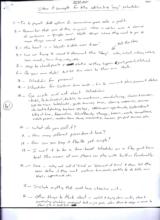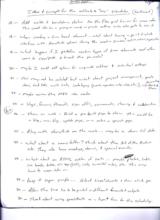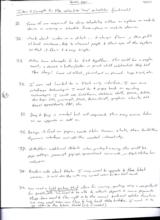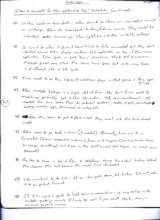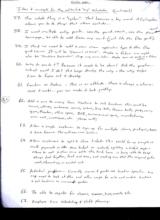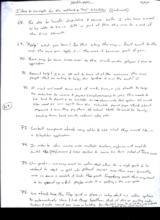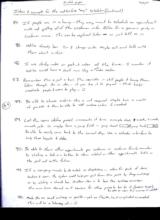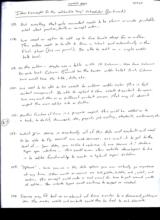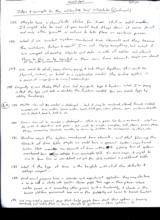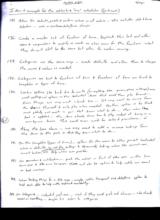|
Basic Assignments
|
Options & Settings
|
Main Time Information
|
||||||||||||||||||||||
|
|
|
|
|
||||||||||||||||||
|
Photo/Image Count: 16
|
||||||||||||||||||
|
||||||||||||||||||
|
|
|
Notes:
|
|
1 February 2011 Ideas & Concepts for the adilas.biz “any” scheduler - This section began 2/1/11 & concluded 3/4/11 1. Tie to payroll. Add options for commission gross sales profit. 2. Remember that one of the original ideas in adilas was a series of containers or “Pringle's cans”. Stuff things where they need to go and move things around as needed. 3. The heart is – “Objects and data over time.” 4. We are trying to record and document the “story”. Tell the story: who, what, when, where, how much, how long, why, etc. 5. Map to check points and status as they happen (past, present, and future). 6. Be your own style! And let the users be their own style. 7. Scheduler for personal. 8. Scheduler for customer time cards – tie to invoices and show payment status. 9. Go onsite and ask about schedulers. • Dental, doctor/medical, rentals, car maintenance, manufacturing, classes and courses, golf tee times, hotel/motel, guide services, trips, cleaning companies, services like heating and plumbing, buy here – pay here, CPA/lawyer’s appointments, customer/client billing of time, reservations, salons/beauty, therapy, lessons, events, competitions, mobile persons, vacation time shares, membership, licenses, pre-paid services, etc. 10. What do you call it? 11. How many different pieces does it have? 12. How can you keep it flexible yet simple? 13. I want it to be a time-based scheduler on a flex grid tie-in level. This means all main players can play with built-in functionality. 14. Time… why not call it “Time” or “Element of time” and then let users define if they want customer time cards, rentals, to do lists, mini blogs, appointments, etc. 15. Include anything that could have a timeline on it. 16. Other thing to think about – rentals and buying down units, share and coordinating schedules, unassigned task or job pools, allow others to assign or move to their pile or task-list. 17. Add visible and basic/admin status. See the flex grid tie-ins for more info. This could also be a privacy or mark as private settings. Who else gets to see it? 18. When creating time based element – what about having a point and click interface with show/hide options during the creation process? Options, actions, types, etc. 19. What happens if I pre-define certain types of time elements and allow users to copy/paste and tweak the pre-sets? 20. Maybe I could add options for corp-wide settings and individual settings. 21. This may not be related but what about project management, goals, ideas, tick lists, wish lists, cataloging (events, agendas, video clips, etc.), or documenting ideas and plans. 22. Maybe review the MDI idea center. 23. Blogs, forums, threads, sign offs, comments, sharing and collaboration. 24. Show on web – build a pre-built page to show. This could be a blog, mini blog, update page, or a sales or specials page. 25. Along with show/hide on the web – maybe a show until date. 26. What about a newsletter? Think about an art company’s website I worked with. They also have meetings, shows, and special events. 27. What about an HTML editor of sorts – maybe photos, links, line breaks, tables, div tags (css), lists, horizontal rules, etc. This may have to come later on. 28. Keep it super simple – select time and objects and then click go. 29. Allow the time line to be printed in different formats and outputs. 30. Think about using spreadsheets as a layout form for the scheduling. 31. Some of the users will be doing scheduling either on a phone of mobile device or viewing a schedule from a phone or mobile device. 32. Think about water in a ditch – it always flows in the path of least resistance. Help to channel people and their use of the system so that if flows and is very simple. 33. Allow time elements to be tied together. This could be a single event, a series, a brother/sister or parent/child relationship. Help tell the story! Cause and effect, planned and un-planned, hay and sad, etc. 34. I am not limited to a Flash only interface. I can mix whatever technologies I need to and piggy back on existing technologies. I could use ColdFusion, database stuff, HTML, tables, div tags, css, Java Script, graphics, charts, MS Excel spreadsheets, PDF, etc. 35. Drag and drop is wanted but not required. This may come later as an upgrade or add on. 36. Design it first on paper, create static screen shots, then build the dynamic interface and add the needed interactivity. 37. Hide/show additional details when printing and viewing. This could be page settings, Java Script pop-ups, spreadsheet comments, or Flash status bar rollovers. 38. Random note about Flash – I may need to upgrade to the latest version. I could also stay with my current version for this first round. 39. We need a light package that allows for invoicing, quoting, using a recipe/build for presets, my cart favorites, groups, advanced grids, etc. We need to be able to attach deposits and invoice payments. These items need to flow right in to the normal back end adilas functions. We may need some new flags to help track states and status. I want it to go clear to the balance sheet (only if needed). 40. On the customer time clocks – allow items to be shown as invoiced/not invoiced or no charge. Allow for time sheets to show/hide on invoice. They could be individual and/or summed up. This might tie in to the visibility settings. 41. I want to allow it (time and elements) to be fully connected but they don’t interfere with normal traffic. Maybe another full application on top of the main application. Time goes in both “known” directions. Think 3rd dimension. Multiple pieces may share the same time space but each may have a different life or life cycle. 42. Time needs to be the one (1) and whatever plays in to that space is the many. 43. Allow multiple bookings in a single slot of time. Also don’t force ends to match-up perfectly. Let it flow like water… fully user-maintained… If needed show some extra flags for potential problems, double, triple, quadruple, booking, overlaps, gaps, disconnects, and waiting lists. 44. Allow the users to put and place what they want into the time-based model. 45. Allow users to go back in time (if needed). Basically, time as it is forecasted (future-somewhat unknown), time as it happens (user may be too busy to change something), and time in the past (what did happen or what was perceived). 46. The key to time is let it flow and date/time stamp and the actual history behind the scenes. This will become the audit trail if needed. 47. Like a virtual to do list – If an item gets done, let it stay. If not, allow it to be pushed forward. 48. If I’m using a quote to hold items or reservations – I may end up with multiple quotes (or invoices). It may be cool if you could stack, chain, or combine quotes and invoices. 49. It might be nice if the scheduler had its own photo gallery. It might also be nice if it had access to the reflexive photo galleries (what is it tied to). The main photo galleries are tied to the main objects. The photo gallery for the scheduler will be more of a one-time deal. 50. What if you could search, filter, and print out different Excel spreadsheets dynamically. 51. Think of the Flash timeline – This is a 2-D, layered timeline with actions, labels, spans, fills, blanks, and color-coded items. 52. What if we took that one step further and added a 3-D or cubic level to the time line. Think about the bricks in a building – Each brick represents a block of time; however, as you look closer at the individual bricks you can start seeing the details that make it up. A brick wall can be the entire wall, just a row, just a column, just a small block of bricks (cluster), or clear down to the details of each and every brick. 53. Most timelines are flat and straight. This is random, but what about a cycle, round, cubic, or infinity timeline model. Just a thought. 54. The scheduler might be a series of 1-many relationships. Each time element could have any number of subs. This could be good for details, follow-up, GPS stuff, tie-ins to other pieces, etc. It may need to go to a 3-deep level. Or more… (See #103 for ideas on subs and snap-ons.) 55. Have each corp start over with an id of one (1) and then increment from there. 56. My dad had the idea of the “any” scheduler – (12/4/10) • All dynamic: - Anything – different application types, general, generic, and build your own - Any place – locations and sub locations (maybe even open or custom) - Any # of events - Any length (time) - Any # of participants - Any price or cost 57. The whole thing is a “system”. That becomes a key word. A full system allows you to do things that others can’t do. 58. I want multiple entry points. Use the quick search, use the time element homepage, and be able to add from any unit (just like the flex grid). 59. I think we need to add a new main application type to the flex grid tie-ins. It will be “Element of Time”. Maybe a future one might also be “Standalone Declaration”. This may come later. Maybe even use quote as a future option. 60. Why do you do it? Because it needs to be done! Ask the question – what would I do? This helps developer the why – the why takes time to figure out and develop. 61. Function vs. Fashion – this is an attitude. There is always a choice. Once it works – you can make it look pretty. 62. Add a one to many from locations to sub locations. This could be rooms, offices, conference rooms, cabins, king beds, queen beds, party room, mini mall, warehouse, etc. (Storage units) 63. Allow a single customer to sign-up for multiple items, packages, classes, and time frames. This could eve cross locations. 64. Allow customer to split and share tickets. This could be as simple as multi payments on the same ticket or actually splitting a ticket. Maybe a restore to cart and then some edits. The trick here is being able to keep things tied together, fast and easy, and making sure that the original gets used, cleaned-up, or voided out. 65. Potential problem – Currently invoice and quotes are location specific. We may need to look at this and allow corps to mix and match locations and sub locations on invoices and quotes. 66. Be able to register for classes, courses, trips, events, etc. 67. Employee time scheduling and shift planning. 68. Be able to handle dispatching and service calls. I also have a need to be able to tie-in GPS as part of this. This may be a sub of the time elements. 69. “Apply” what you learn! Do this along the way. Don’t wait to the end. The more you apply it – the more it becomes a part of you. 70. There may be some cross-over to the multi-media player and training application. 71. Recruit help! It is okay not to have all of the answers. The more people that are willing to help, the better it is in the end! 72. I want and need some sort of work, time, or job sheets to help tie activities to invoices and payees (employee/users) to jobs. This needs to tie back to payroll and be available as a dynamically fed option. It would also need its own report from the calculate payroll page. Think about the ski mountain I worked for and how they pay their ski school staff. It could be hourly, teaching time, head counts, referral rates, etc. 73. Contact companies already using adilas to see what they would like in a scheduler application. 74. In order to allow invoices with multiple locations, maybe we will need to switch the (P&L) revenue and COGS sections to invoice line items instead of the main invoice. 75. On quotes – we may need an option that allows for a single quote to be restored to cart or split into different invoices more than once. Currently, once an invoice is created, it locks the quote from being used. This may need to be opened up a bit. Maybe make it a setting on the main quote. 76. We already have the flex grid in place – why don’t we allow options to automatically chain and link things together. Think of this as putting water fountains and sinks around your house or building. You shouldn’t have to go all the way outside to get the water source. 77. What about events and classes. This might be a mix of dates and participants. Depending on how tight the scheduling is, I could see an alternating schedule and/or multiple classes/labs being scheduled back to back. Think of a class at Bridgerland or room at the University. Either way you might need multiple start and end times. How do you keep all of the participants tied to each date and time? Roll call. 78. Some events and classes will be in rented or non-permanent locations. We might want a choice to select from a list of locations and sub locations or enter a temporary or custom location. 79. Spent some time in Staples Office Supply Store in the planner and appointment book section. Think very simple like a day planner, to do list, desk calendar, etc. 80. Allow preset blocks – seconds, minute, ¼ hours (15 minutes), ½ hour, and hours. The user could then see and choose the level without typing anything. It would also be cool to let them see start and stop values. For example: My dad always begins at 6:00 am and ends at 8:00 pm (whatever). If something custom is needed it would also show up. Maybe even have a button for 24 hours (if needed). 81. Time – slots, as many or as much as needed. Items, rooms, persons – as many or as much as needed. 82. We many want the users to choose between simple vs. complex time elements. They also need to be able to show results on different levels. (See #103 for info on subs and snap-ons.) 83. Online reservations and registration will lead right in to online eCommerce. We need to plan for that. Along with that – we also need a way for customers to pay their bills and see history (activity) and outstanding values. Self-service. 84. If people are in a hurry – they may want to schedule an appointment without getting all of the customer info. Allow for a generic party or customer name. This can be replaced later on or just left as is. 85. Adilas already has 2 or 3 storage units. Maybe call and talk with them about wishes. 86. I use sticky-notes or post-it notes all the time. I wonder if adilas could have a small mini blog or quick notes section. 87. Remember this is just a tool. The variable is still people and having them follow through. As an idea – if you tie it to payroll – that helps motivate people and users to play. 88. Be able to choose colors. This is not required. Maybe have a number of pre-sets and then be able to add custom colors if needed. 89. Let the users define preset increments of time – a couple days, 1 week, 2 weeks, a month, etc. Or maybe have a jump field – jump ahead, jump back. Be able to easily come back to the current day. Use a calendar interface to help show layouts and dates. 90. Be able to show other appointments per customer or customer family member by clicking a link or a button to show related or other appointments both in the past and in the future. 91. If a company wants to do rentals or dispatching – allow for pools of items, locations, and users. The system could help you pull from the pools by drag-and-drop or by clicking a check box. Another idea is to have the system remember the main time element as it searches for other pieces to tie to it. (Session scope) Be able to clear the memory if needed. 92. Make this as small and easy as possible – yet as flexible, bit, and complicated as needed. This will be a balancing act. 93. Be able to mark things in/out of play. This could be workers on a crew, service trucks, equipment that is in the shop or being fixed – help coordinate what is going on. 94. Templates of time, start and end time ranges, days of the week that are in play, etc. Be able to set known times and standard occurrences – weekly, meetings, training, lunch breaks, etc. 95. It may be line managers or crew chiefs that are setting up schedules for their employees. Each crew or line may need the flexibility to switch crews, locations, shifts, etc. 96. Be able to schedule a webinar. 97. Allow a buddy system on tasks, ideas, comments, and assignments. 98. Time also deals with the future like goals and forecasting. It could also be used to determine reality vs. planned. I could see a manager setting a goal for each day – then a crew manager entering an actual for each day. That would allow the person(s) to monitor progress and actual output. 99. If you were in manufacturing – you could even schedule production runs, needs, and demands. What about maintenance schedules. 100. It would be pretty cool if the system could help send you reminders . This could be email, screen pop-ups, text messages, etc. As a side note – some scheduling applications use MS Outlook as the platform and then use a MS exchange server as part of the application. Maybe a notification@adilas.biz or reminder@adilas.biz email form or address. 101. Estimates, quotes and job costing. The goal here is to gather up the details and show how they relate to income and costs. This could include supplies, parts, labor, time, overhead, rentals, sub-contractors, project management, fees, etc. It might be nice to have a report that shows what is revenue and what is a cost or expense. The goal is the bottom line or profit margin. Many times, the element of time plays in to these types of jobs. 102. A couple of things to think about – sign off requirements, sign off by who, changing status and how long in each section (aging of changes), assignment changes, aging in the queue and/or running time between phases or status. 103. What I’m seeing develop is a simple time object that can have all sorts of subs or pieces stacked on. Kind of like Legos. The main would hold and carry all of the subs. Each sub section has the functionality built in to it, not the main time element. This allows for known actions to be “snapped on” and they already know how, where, when, and how much to play. Maybe a “time snap-on” or “element snap-on”. Build the functionality in to the subs and options. Maybe just call it and “add-on” or an “add-on component”. 104. Once we go clear to eCommerce – we will need to know what to do (instructions), what to show, and how to show availability and bookings. 105. Each element of time may be tied to a master recipe or template. This will show options, show/hide “snap-ons”, and set requirements. 106. Be able to schedule payments and due dates. This is money coming and going. Think of a bank collecting on a loan or a buy here pay here checking to see if their buyer is on time. This could also be for monies going out. 107. Almost every element or piece inside of adilas is related to time. Is there a way to bring things together without making the user duplicate their efforts? Basically, we have tons of stuff that is already getting assigned to an element of time. I would love for that stuff to show-up and be counted as well. Adilas – All Data Is Live And Searchable. 108. Reoccurring invoices (and expense/receipts and balance sheet items – not done yet) need to show up as an element of time. 109. I’m sitting here thinking about how every piece of the puzzle is tied to an element of time. I’m also thinking about how I could have missed this “Big” of a component of the entire picture. We have been running things for years and only now is it clicking and making more sense. I’m grateful that I’ve had time to soak some of this in. 110. There are six pages of notes in my mini notebook dated back in 8/27/08 under the topic of reoccurring invoices. Here are some highlights and/or ideas: - Inter-corp options, master/sub relationship, be able to turn on/off the master, back tie to units to help buy them down (physically and/or depreciation adjustments), normal operating hours for each unit, only show those hours unless the full 24 hour link is clicked, be able to search for available dates and times, be able to cancel and back things out. - Need in/out stamps for check in/out, booked vs. actual usage, special notes and/or instructions per booking. Think general to specific, average time slot per unit. - What about capacity, # of guests (customers), optimal #, min #, max #. - Productivity reports (booked, used, optional), assignments (requests), mass entry (recipes), different reports that deal with dates, time ranges, capacity ranges, available, booked, etc. - Rate tables for seasonal use, waiting list feature, cleaning status on each unit, package deals, late fees, cleaning fees, other fees. 111. We want to add a sales and promotion section to adilas. Maybe customer reword programs, promotion codes, sales, and seasonal pricing can play in to time. This deals with loyalty programs, points, rations, and marketing campaigns. 112. Marketing and promotion is a huge part of business. Help them start to manage that as well. 113. For drag and drop or selection pools – what if we actually create a second or sub time element for items that are not available. Basically, one pool for active and one pool for inactive or out of play. This may be able to be done by reverse association but I wanted to add it as an option. 114. When going to drag and drop. Use the adilas multi-media player to show and display elements. Include interactions between the left sub and right main panel. 115. At some point we wanted to add specific medical records. The elements of time might be a perfect spot. This would be as a sub or add-on component. 116. What about someone that goes to a resort. Everything goes on a tab and then could be pulled together. It might work cool if you could stack or combine invoices. Another cool thing might be to limit line items by date range and then print or show to your client. 117. Not everything that gets recorded needs to be shown or made printable. What about practice, draft, or concept notes. 118. We need an option to add up to five levels deep for an outline. This outline needs to be able to form in html and automatically in the Flash player (sub nav panel). Be able to edit on a single and/or bulk level. 119. On the outline – maybe use a table with 10 columns. Use two columns for each level. Column 1 (one) would be the Number and/or bullet point. Column 2 (two) would have the title, data, etc. 120. We need to be able to tie assets to outlines and/or subs. This is full content management. Be able to upload and store assets and content for users. We many want this on a different content server. That way it doesn’t impact the main adilas site or traffic. 121. Another function of time is a progress report. This could be added on to a task, to do list, document, idea, project, job costing, students, customer, etc. 122. What I’m seeing is eventually all of this data and content will need to be able to fly around via web services. We want it to get to the level of… “Your data, you cache and retrieve it, we secure it.” Make a super open interface… This could even allow outside developers to tie in to adilas functionality to create a hybrid super solution. 123. “Sphere” – once you are in the data sphere you can virtually go anywhere at any time. Other words or names are ball, global, bubble, orb, orbit, and realm. This concept could make a cool visual for how to get around inside of adilas. The outside layers could continue to expand as needed. 124. Training may fit best as an element of time similar to a document, outline, or idea. The media assets and contents could then be tied to sub elements. 125. Maybe have a show/hide status for items still in edit mode. It might also be cool if you could lock things down at some point and only allow growth or actions to take place on certain pieces. 126. What if we created system-maintained time elements and they became the watchers. Return and report! I’m not saying everything, but what if we wrapped all existing objects and data inside of adilas and allowed them to play or be counted in their own time element. Maybe one element per day with unlimited financial subs. 127. We need to stitch, sew, chain, group and link things together. This could be physical, virtual, or based on a relationship model. The entire system is a series of 1 to many relationships. 128. Originally I was thinking that time had two parts type and function. What I’m seeing is that the type just tells or dictates the functions needed. You can create type by adding function(s). 129. Matter – cannot be created or destroyed – but it may be combined, altered, formed, molded, compressed, etc. Fine matter, course matter, liquid, solid, gas, vapor, plasma, pure, contaminated, etc. Cut it, stack it, bend it, break it, etc. 130. Time – cannot be created or destroyed – this is a give (as far as we know) – what we do with it depends of each person. It could be simple, complex, self, others, persons, places, things, reoccurring, standard, variable, by choice, by dictation, by consequence, by others, etc. 131. Question about the system –maintained time elements – will that blow-up the elements of time table. Maybe we could have a special system-maintained section that mimics the elements of time without adding tons of system-maintained items (non-editable and non-searchable (ish)). In some ways, it might be nice to leave time as user-defined and put the daily watchers in a different table. 132. What if the type of time is the template with all of the defaults and settings assigned. 133. Most email programs have a calendar and appointment application. They may also have a to do list or sticky note section. Some people have apps on their phone. Where adilas comes in is connecting other pieces, built-in functionality, and already in the business platform environment. We win on the scalability and tie-ins to business functions. 134. We may need a special page that helps people know about their options – training eventually, but before that – some sample and guidance… show options. 135. Allow for defaults, presets, and custom values on all entries. This includes date and time selection – auto or custom date/time stamps. 136. Create a master list of functions of time. Duplicate this list and allow users and corporations to modify or create an alias name of the functions. What they do will still be the same but allow for custom naming. 137. Categories are the same way – create defaults and allow them to change the names and values as needed. 138. Categories are tied to functions of time and functions of time are tied to templates or types of time. 139. Certain settings, like back tie to units (or anything else – persons, places, or things) may need settings and options on the individual items that could then play forward. Even though we may want a back tie – It may need to come from the items themself and only play when needed. Another option is to think more globally and create a pool that knows what to do – then when the pool is update, the items already know how to play instead of being on a one-by-one basis. This could even work for sales and promotions. 140. Along the lines above – we may need to add a reverse look-up from the items to the pools so that they know what to do. 141. On the templates (types of time) – allow for the users to either preset hardcoded values or defaults or set the settings to dynamically look-up values like current user, current location, current date, current time, etc. Help wherever possible. 142. On reminders and notifications – push the valves in front of the user on the time homepage and the main homepage. There will also be options to help notify via email or text message. 143. When booking things for a date range – maybe add a transparent sub date/time option to hold each date to help with booking and availability. 144. On categories – instead of just one, what if they could pick and choose – like check boxes or something, maybe tie colors to categories. 145. When showing people how the elements of time work – show them a very basic drawing of the key pieces. (Templates have functions and functions have categories). 146. “A fox that chases two rabbits catches neither.” Focus and get the job done! Then move on. 147. When looking at a single item – show the bookings for three months. This may help to get an idea of usage and availability. 148. Sometimes the prep is more important than the jump. 149. On the templates – It might be nice to add an option to preset sub default titles. Either separate with commas or add a one-to-many relationship. Look at the flex grid titles for ideas. Options may include leave blank, a set value, or a list of values to use. 150. I may need to “dummy” things way down. This is like going hunting with an army, planes, tanks, and ships – when all that is needed is a small gun and some bullets. I know that it is a balancing act, but less might be more. 151. Currently we have a template that controls the elements of time. What if we had some settings that controlled the templates? 152. I can see a market for a scaled down version of adilas – say an adilas express or something like that. - Maybe a home version, a business starter version, an entrepreneur version, a small business, and a medium or large business, maybe an enterprise level. Okay, just took it too far again. 153. In conference on (4/3/11) I heard a talk that was talking about basic needs. The question was posed- will this buy me any bread? Cover the basic needs before we go tweaking to the “nth“ level. Keep it simple! 154. We may need to rate a table per user or per tech. This would automatically tie in to the rate or general amount according to who was assigned and the total time. From Post-it notes: - Group Meetings o Use technology to get the biggest impact - Group Training Sessions - Group Invites/Seminars - Newspaper ads - Flyers - Adilas theory demos - Webinars - Video capture, Dimdim, simple drawings, and power-point slide shows - Use Steve’s house until we grow out of it On customer site: - Easy contact info: o Email form o Phone #’s - Video demo o Overview o Specific tasks or concepts - Maybe a tutorial link or help files - What about showing general pricing and allow credit card payments and sign up - Adilas express - Adilas non-profit - Maybe allow the users to select # or users, # of locations, # of invoices or annual gross sales, send email requesting a quote. |

